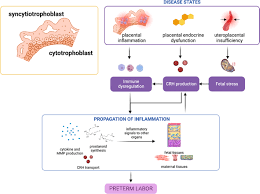Maternal Plasma Lipid Profile as a Potential Risk Factor for Spontaneous Preterm Labor
DOI:
https://doi.org/10.69667/rmj.25204Keywords:
Spontaneous Preterm Labor, Term Pregnancy, Lipid Profile.Abstract
This study seeks to assess whether the maternal plasma lipid profile acts as a risk factor for spontaneous preterm labor. In this hospital-based retrospective case-control research, 70 pregnant women were included in 35 cases of spontaneous preterm labor and 35 cases of term pregnancy who had labor pain and were admitted to the Maternity and Children Hospital (MCH) for delivery between January 2023 to January 2024. We used the logistic regression method to determine the plasma lipid profile for risk factors of spontaneous preterm labor. The case group had significantly higher plasma levels of low-density lipoprotein, triglycerides, and total cholesterol, 31.4%, 45.7%, and 17.1% than the control group, respectively. All the potentially risk factors with their p-value ≤0.05 were taken for logistic regression. linear regression the elevated levels of triglyceride, total cholesterol, and low-density lipoprotein was detected to be associated with 2.92-fold (1.62‑3.24,95% CI, p < 0.001), 3.31-fold (1.30‑4.99,95% CI, p = 0.001) and 2.88-fold (1.75‑3.19,95% CI, p = 0.002) higher risk of premature labor, respectively. A higher risk of spontaneous preterm labor may be associated with elevated serum levels of triglycerides, total cholesterol, and low-density lipoprotein, which could be regarded as a risk factor for this pregnancy issue.

Downloads
Published
Issue
Section
How to Cite
Similar Articles
- Nowar Bhari, Hamed Bogdadi, Shamsi Saad, Fagonia glutinosa from Libya as a Potential Source of Lead Compounds: GC-MS Characterization of Metabolites with Antimicrobial and Anticancer Activities , Razi Medical Journal: Volume 1, Issue 3, 2025
- Milad Elshah, Mohamed Zeglam, Asmaa Abdeewi, In vitro Comparison of Fracture Toughness Among Three CAD/CAM Fixed Prosthodontic Materials , Razi Medical Journal: Volume 1, Issue 4, 2025 (October to December)
- Raja Moman, Nouralhuda Altair, Abdulkarem Tamer, Amnnah Ghalbun, Nagat EL-Magrahi, Antibiosis of Antibiotics, Honey and Probiotics Related Bacteria to Diabetic Foot Infections , Razi Medical Journal: Volume 1, Issue 1, 2025
- Ahmed Aniba, Mustafa El-ahmar, Omar Danfour, Fathe Abulifa, Mona Abujazia, Mohammed Elfagieh, Integrated Surgical and Anesthetic Management of Pediatric Small Bowel Obstruction Due to Foreign Body Ingestion: A Comparative Case Series on Anatomical and Perioperative Implications , Razi Medical Journal: Volume 1, Issue 4, 2025 (October to December)
- Mariam Alqasser, Stroke Incidence and Risk Profile in Misrata City: A Retrospective Cross-Sectional Hospital-Based Study from Emergency Medical Records (2019–2020) , Razi Medical Journal: Volume 1, Issue 4, 2025 (October to December)
- Mohamed Zeglam, Mohamed Altier, Hala Alhawij, Mohamed Abuagila, A Cross-Sectional Assessment of Bacterial Contamination in Fixed Prosthodontic Impressions Transferred from Clinics to Dental Laboratories: A Study in Tripoli, Libya , Razi Medical Journal: Volume 1, Issue 3, 2025
- Faiza Nouh, Salima Elfagi, Mohamed Buzqeia, Ahlam Adel, Mawadda salah, Enas Hassan, Safa Edress, Determinants of Food Choices in University Cafeterias: A Cross-Sectional Study Among Public Health Students in Libya , Razi Medical Journal: Volume 1, Issue 4, 2025 (October to December)
- Heba Awad, Ishtar Imad, Fatima Abd-algabar, Hani Attia, Dhuha Hadid, Alaa Abed, Safaa Ahmed, Serum Testosterone and Estradiol Profiles in Patients with β-Thalassemia Major , Razi Medical Journal: Volume 1, Issue 4, 2025 (October to December)
- Hasna Akub, Tawfeek Altawaty, Aun Youis, Seroprevalence of Human Immunodeficiency Virus Infection and Demographic Correlates among Individuals Tested in Al-Jabal Al-Akhdar, Eastern Libya: A Cross-Sectional Laboratory-Based Study , Razi Medical Journal: Volume 1, Issue 4, 2025 (October to December)
You may also start an advanced similarity search for this article.








